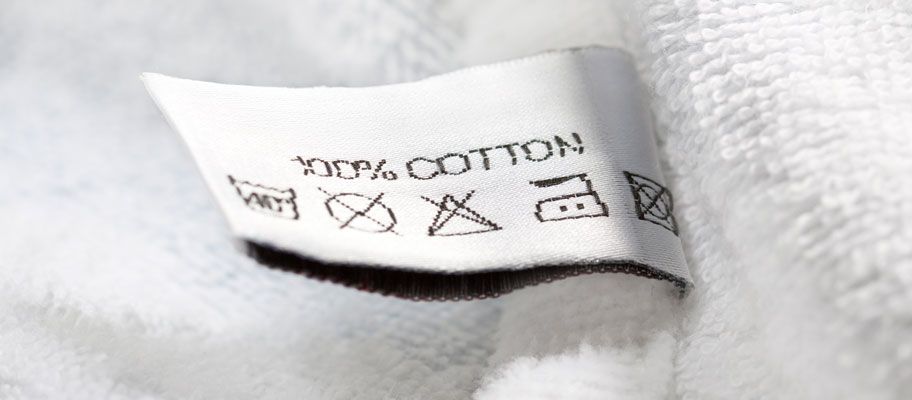We use cookies to give you the best possible experience. To accept cookies continue browsing, or view our Cookies Policy to find out more.
Laundry Advice - Tips On Washing & Ironing Linen
|
December 13th, 2019

Towelling Products
- New towelling products should always be given a hot wash with detergent before use. This will prevent threads pulling.
- Shake out towels before loading into the washing machine to allow the wash liquor to penetrate.
- Detergents containing optical brightening agents will improve the visual brightness of white towels.
- For coloured towels use a detergent that does not contain any optical brightening agents as this will mask the true shade and diminish the colour.
- Coloured towels should be washed with similar shades and white towels only washed with white. Coloured lint contamination will ruin the appearance of towels if wash loads contain notably different colours
- Washing in hard water can give a harsh feel to towels.
- Fabric conditioner can be used to improve aroma and softness of the towel, however this lubricates the fibres which reduces towel absorbancy and can lead to fibre loss.
- Do not over dry towels in the tumble dryer. This can lead to a dull, grey appearance.
- Do not use towels to clean up bathroom spills or to wipe down after cleaning. Beauty products and bathroom cleaners can discolour or damage the towel leading to holes.
Polyester Table Linen
- Do not mix colours on the first wash. Residual dye/chemicals may be present from manufacture which may cause cross contamination.
- Always wash white table linen on its own to prevent dye contamination from other colours
- Subsequent washes can be classified according to colour e.g. pale shades such as peach and pink can be washed together at lower temperatures (less than 60C).
- Wash loads should also be classified according to the degree of soiling.
- Do not mix fibre types. Washing and/or drying 100% cotton and polyester/cotton blends with 100% polyester table linen will result in cotton lint attaching to the surface of the polyester fabric giving the appearance of pilling (or “bobbling
- Shake out table linen to remove and cutlery, solid food residues and other foreign objects before loading into the washing machine. Items such as knives and pens can damage or permanently stain the fabric.
- Detergents containing OBA (Optical Brightening Agents) are only recommended on white goods. This will make a white fabric appear whiter and brighter.
- The use of detergents containing OBA can alter the appearance of coloured shades giving the impression of colour loss. Coloured fabric should ideally be washed in detergents that do not contain OBA.
- Residual staining can be removed using oxygen based bleaching agents but these should not be substituted for a good wash process with adequate detergency. Care and attention should be given to the conditions of use.
- Chlorine bleach (Sodium Hypochlorite) can cause permanent colour loss and shade changes and should be avoided.
- The wash temperature can affect the fabric quality. If polyester is washed at 60C, a cool down stage must be included between the high temperature wash and cold temperature rinsing. The wash liquor temperature should reduce to 50C and a rate of approximately 4C per minute.
- High temperature washing can without a sufficient cool down stage can result in Thermal Shock Creasing. This occurs when hot, soft and pliable polyester fibres are cooled too quickly whilst in a crumpled state. This results in small “broken ice” type creases on the fabric surface.
- For best results polyester table linen should be ironed dry. Always feed the fabric into the ironer whilst damp.
- Higher ironer bed temperatures (above 170C) on modern machinery can cause softening and distortion of polyester if consistently ironed in the same direction. Altering the direction of feed after each wash will minimise this effect.
100% Cotton
- New cotton items should be washed before use to remove and loose fibres and remove any residual chemicals from manufacture.
- Shake out table linen to remove and cutlery, solid food residues and other foreign objects before loading into the washing machine. Items such as knives and pens can damage or permanently stain the fabric.
- Always wash white goods on their own to prevent dye contamination from other colours
- Do not mix colours on the first wash. Residual dye/chemicals may be present from manufacture which may cause cross contamination. Classify wash loads according to similar colours for subsequent washes.
- Wash loads should also be classified according to the degree of soiling.
- Detergents containing optical brightening agents will improve the visual brightness of white cotton goods.
- For coloured goods, use a detergent that does not contain any optical brightening agents as this will mask the true shade and diminish the colour, particularly on 100% cotton items.
- Residual staining can be removed using oxygen based bleaching agents but these should not be substituted for a good wash process with adequate detergency. Care and attention should be given to the conditions of use.
- Stain removal using Chlorine bleach (Sodium Hypochlorite) will chemically damage and accelerate the weakening of cotton fibres. Over/repeated use will cause sufficient damage to easily tear the cotton. On coloured items, Chlorine bleach will cause permanent colour loss/shade change and should be avoided.
- Cotton is more resistant to heat damage and white goods can be washed at temperatures up to 90C to remove heavy staining.
- Coloured items should be washed at lower temperatures not exceeding 50C to minimise colour loss.
- Natural starches can be applied to cotton table linen to impart polish and stiffness where required. Starching should take place on the final water based stage of the wash process after the fabric has been cleaned and all wash chemicals neutralised.
- Ironing of cotton should be done whilst damp and is essential to complete the drying process, remove creasing and improve its aesthetic appeal.
Polyester/Cotton Blends
- Wash loads should be classified according to colour and soiling level.
- White items should be washed separately to prevent cross contamination from coloured items.
- Do not wash with 100% cotton/100% polyester goods.
- Detergents containing optical brightening agents will improve the visual brightness of white polyester/cotton goods.
- For coloured goods, use a detergent that does not contain any optical brightening agents as this will mask the true shade and diminish the colour.
- Residual staining can be removed using oxygen based bleaching agents but these should not be substituted for a good wash process with adequate detergency. Care and attention should be given to the conditions of use.
- Stain removal using Chlorine bleach (Sodium Hypochlorite) will chemically damage and accelerate the weakening of cotton fibres in the blend. Over/repeated use will cause the cotton fibres to degrade leaving a thin, shiny fabric due to the remaining polyester. On coloured items, Chlorine bleach will cause permanent colour loss/shade change and should be avoided.
- The first 4 to 5 minutes of the wash process should be carried out with a temperature below 40C to prevent setting any protein stains.
- The wash temperature can then be increased to 60C for white items or 70C should the soiling be cooking oil or grease based to encourage emulsification.
- If polyester/cotton is washed at 60C or above, a cool down stage must be included between the high temperature wash and cold temperature rinsing. The wash liquor temperature should reduce to 50C and a rate of approximately 4C per minute.
- High temperature washing without a sufficient cool down stage can result in Thermal Shock Creasing. This occurs when hot, soft and pliable polyester fibres are cooled too quickly whilst in a crumpled state. This results in small “broken ice” type creases on the fabric surface.
- Natural or less commonly synthetic starches can be applied to poly/cotton table linen to impart polish and stiffness where required. Starching should take place on the final water based stage of the wash process after the fabric has been cleaned and all wash chemicals neutralised.
- Ironing should be done whilst damp to complete the drying process.
- Higher ironer bed temperatures (above 170C) on modern machinery can cause softening and distortion of polyester if consistently ironed in the same direction. Altering the direction of feed after each wash will minimise this effect if possible.
Looking for more laundry advice? Be sure to read our article on common linen problems and how to solve them.






